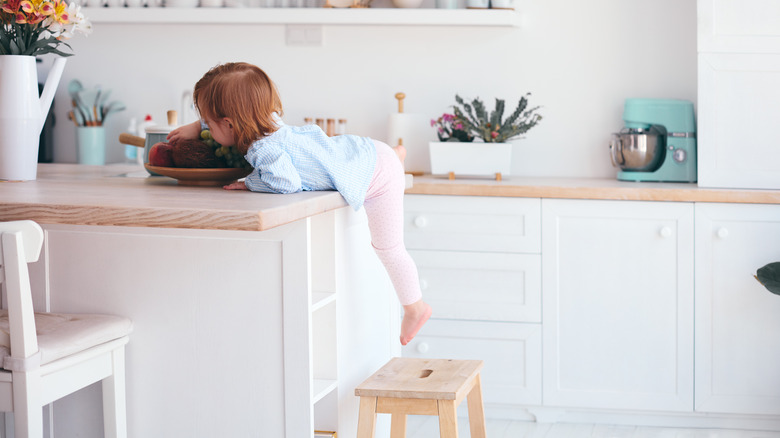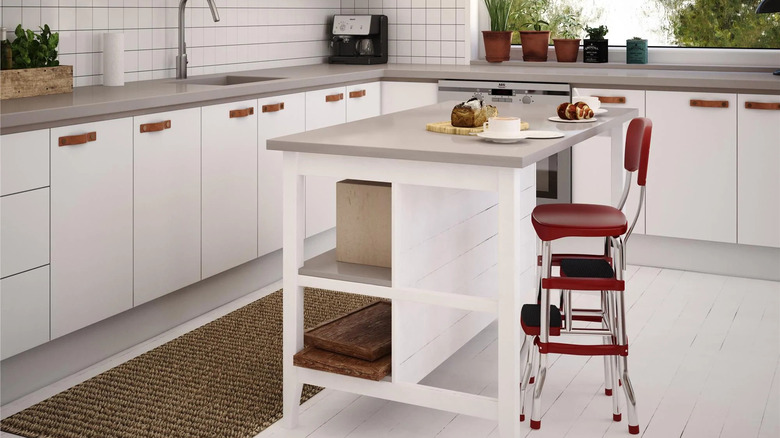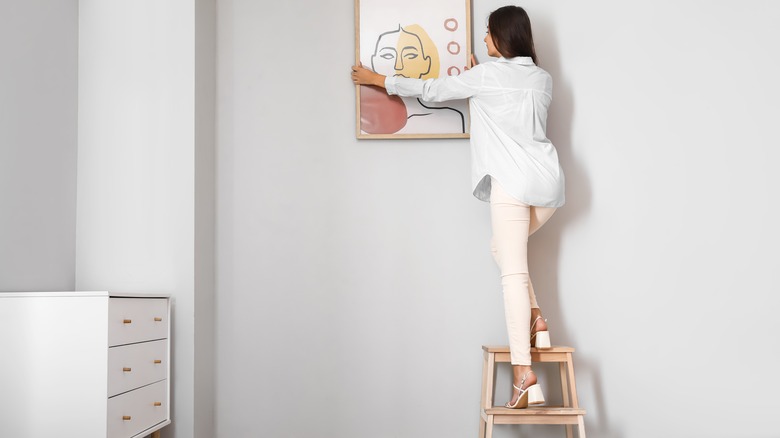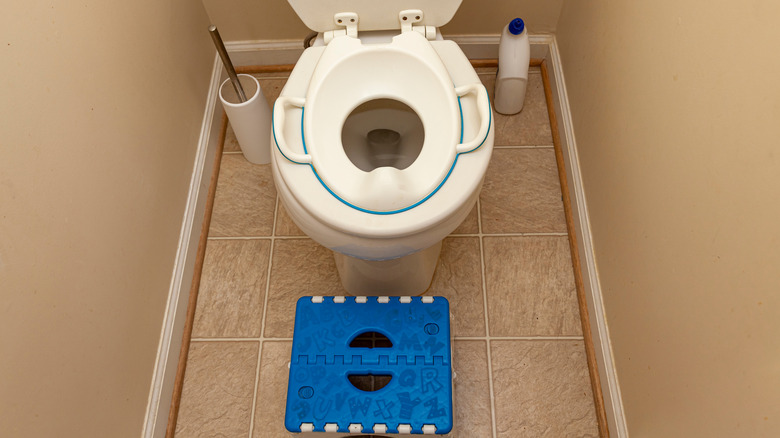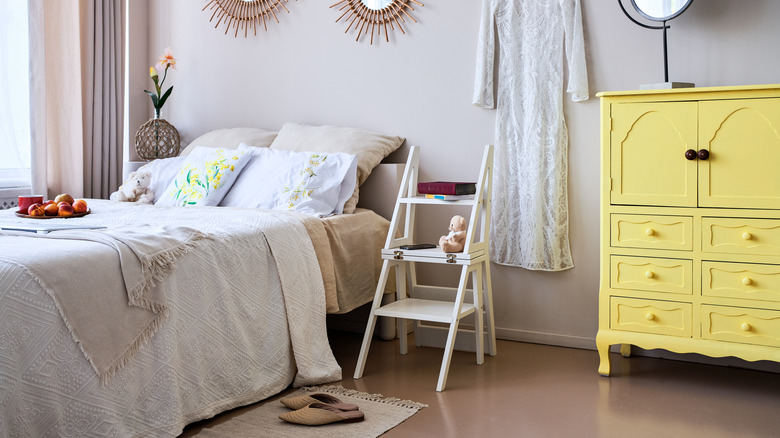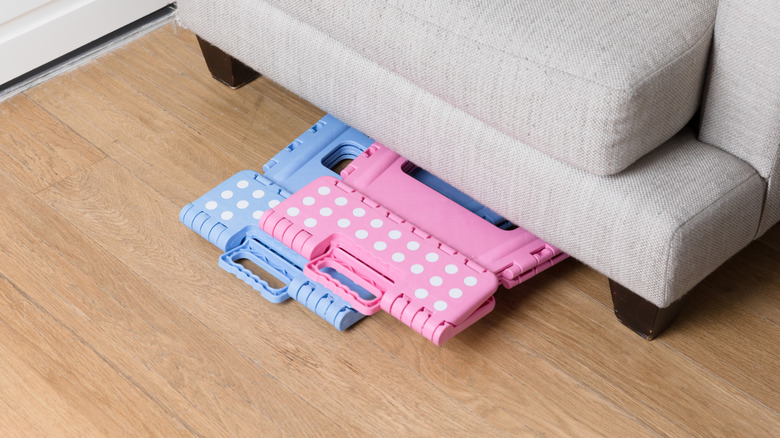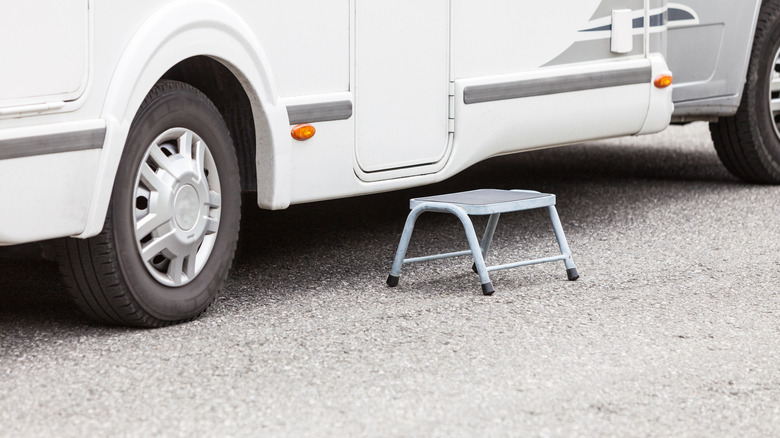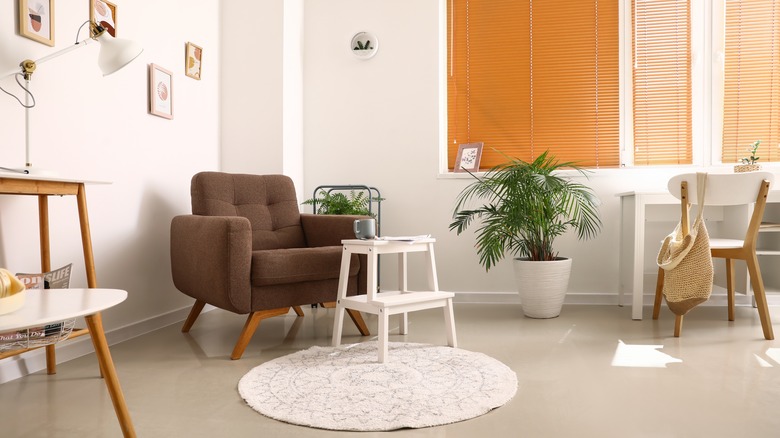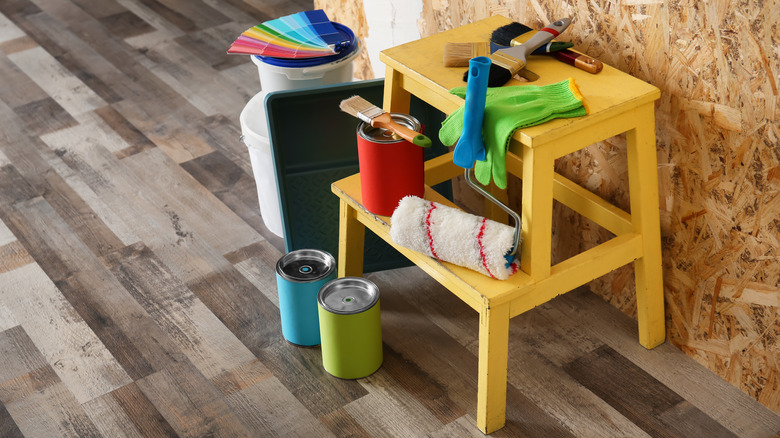How To Choose The Right Step Stool For Your Home
We may receive a commission on purchases made from links.
From those little wooden things kids stand on when brushing their teeth to the oddly shaped wheeled contraptions in libraries to five-foot-tall steel behemoths you have no idea where to store, there's a huge variety of what we call "step stools" out there, and you probably don't need most of them. But the ones you need, you really need.
In fact, acquiring a variety of step stools is Little People of America's first recommendation for affordable home modifications. But these aren't just for short people; there's something around every home that no one can reach... something stored or hidden up high, or something high that needs attention.
There are lots of ways to categorize step stools. One way is to start with two main types: folding, ladder-like models, and simpler non-folding models. The ladder-like models are the more complicated and arguably the most generally useful. In fact, the ladderish step stools have been refined to the point that now actual ladders are starting to take on their features. Wirecutter's best ladder list from June 2020 picks a Gorilla fiberglass model that's indistinguishable from a step stool except for a slight difference in height and number of steps. All of this comports with OSHA's predictably businesslike definition of a step stool as "a self-supporting, foldable, portable ladder, nonadjustable in length, 32 inches or less in overall size."
Non-ladder step stools are a varied lot, from upturned wooden boxes to elaborate chairs that either hide a stool in their works or look darned weird trying to. But for now, let's plant a picture in your mind of a small, wooden, two-step stool. It might have a hand-painted design on it, and perhaps a hinged top step for storing pretty rocks and broken toys you don't want mom to know about.
The timeless appeal of the step stool
From time to time you'll find someone waxing poetical about step stools, in a way one is unlikely to about bookends or an immersion blender. Consider this mother writing at Kitchn about her daughters' stools and her favorite memories that feature them. (Her oldest daughter has a savant's grasp on exactly what to do with kale from the great height of 12 inches.) For this mom, the stools represent the growing part of "growing up," when kids try to reach a bit further than they're really equipped to.
Or consider this little essay on Harry Rinker's collectibles site, in which Rinker describes an aunt who always showed up during dessert and perched on an iconic Cosco Counter Chair/Step Stool combo to at first refuse, and then accept dessert. This is a classic step stool story, about a classic stool: it's not there for everyday use, except when every day provides a reason to have an extra seat on hand as well as a means of getting to hard-to-reach storage areas.
Because they're so universal and universally loved, old step stools can command respectable prices on the antiques market. But, also because they're universal, the Cosco stools in particular aren't prohibitively expensive. Vintage Unscripted says you'll find a Cosco step stool at almost any estate sale, so pristine versions might bring $150 (via Love to Know), but well-used versions might be worth $5 or $10, according to Harry Rinker. You're not going to find a better price for a time machine.
Why everyone needs a step stool
Aside from reaching library shelves and brushing kids' teeth, what is the point of these things anyway? Well, they're almost too useful to quantify. We've seen them used to hide things, steal things, fix things, tear things down, or seat someone for a quick chat.
The absolute best use of a step stool, normally a device to make one momentarily taller, was to make its owner, Emilie Orton, shorter rather than taller. After Orton was diagnosed with ovarian cancer at 32, the mother of three prepared for treatment-induced baldness by sitting down on a step stool and having her four-year-old daughter give her a haircut. She wrote up the experience for Romper, and if you think you know of a better use for a step stool, you're out of your mind. (By the way, Orton is now the mother of four, and that story is even better.)
Of course, ideally you'll have more mundane uses for your step stool. In fact, you almost certainly do. They're a must for home maintenance and repairs, unless you want to lug a full ladder everywhere, knocking things over and breaking more than you'll fix. They're a boon for those of us with high pantry or garage shelves. They're on Wirecutter's list of best gifts for one-year-olds. Oh, and they're great for your health from a few angles. The EPA describes step stools used in an aerobics program for smokers, and the Canadian Journal of Emergency Medicine says their use improves CPR administered to children. Surgeons even stand on step stools to get a better angle on their work (via Medicus Health). The point is that everywhere you look, someone's on a step stool.
Step stool safety
But step stools, like many things, are good for your health until they're not. In 1979 John Locke Associates, presumably with consummate empiricism, published a study called Hazard Analysis of Step Stools, which found that more accident victims arrived in emergency rooms as a result of step stool falls than from bars, bar stools, and hassocks combined. No word on ottomans. But when something causes more accidents than bars and bar stools, you have to be on your guard. A decade later the Consumer Product Safety Commission (CPSC) published research showing the dangers of step stools, finding that women, people over 55, and children under 5 are the highest-risk groups of step stool users. The study further found that accident victims were usually carrying an object, and were usually standing and reaching, which is singularly unsurprising. What else would you be doing on a stepstool? If research found that most step stool accident victims were eating kale at the time, that would be at once surprising, useful, and a culinary windfall as well.
Advice for using a step stool safely is pretty uniform across the board, from the OSHA standards for their construction and use to the ASTM's standards for children's stools, which are now included in CPSC regulations. The American Ladder Institute, which has adopted the OSHA step stool definition verbatim, urges safety measures that are very like ladder safety measures (via the Weekly Safety blog): Use them on level surfaces with all feet on the ground or floor; watch, block, or lock doors that might collide with your step stool when opened; in general, face a ladder-style stool when using it; don't attempt to shift the stool while you're on it; and don't use a metal step stool for electrical projects. Also, don't leave a folding step stool set up where children can access it.
Categories of step stools
Things with so many uses are usually grouped into lots of categories. These categories probably don't matter as much to you as features, and features will be your first way of filtering through what you might consider buying. But categories are useful to get the lay of the land. You could start by identifying the age of the intended user, which Walmart helpfully labels "Lifestage." Less usefully, Walmart notes 9 step stools that are appropriate for newborns, including a 17-foot ladder with a 300-pound weight limit (though it later notes the ladder represents a choking hazard and "is not suitable for ages under 3 years.")
On the other hand, commercial broad line distributor Grainger uses nine categories of step stools that have a distinctively business-oriented bent, ranging from the simple round "office stools" (which you might associate with schools or libraries) to some miniaturized rolling steps you might find at a Lilliputian Home Depot. These categories (sawhorse ladders, for example, and rolling platforms) focus on the sorts of industrial products Grainger offers, and you're probably not going to find a category for pink, flowery wooden stools there.
Ultimately, most practical categorizations are covered in the features we'll discuss below. Decide what you care about most and call that the category you're interested in. Unless, that is, you're interested in a stool of such a specialized purpose that it can't really be grouped with many others. These are the specialty step stools.
Specialty step stools
Some step stools are designed (and named) in such a way that they clearly have an intended use in mind. We've touched on a few already: step stools for children, kitchen stools, step stool chairs. There are many more. Midwest Montessori describes lots of different stools appropriate, it says, to a "Montessori home," by which they seem to mean a "home where children do things other than watch television." This sort of list overlaps, of course, with a list of kitchen-appropriate stools, which could include just about anything but certainly includes the Cosco classic, which also represents another big group of step stools you can think of as "step stool chairs" (via Dusty Old Thing). If you want to feature something besides a step stool in your fancy kitchen, there are always integrated hideaway models like the Step 180 (via Hideaway Solutions).
Step stools made specifically for workshops might be the most flexible designs around, but they aren't always the prettiest (via AZtool1). You won't find a better example of the genre than the Sharper Image Rolling Toolbox Stool (via Amazon). Bed step stools can also look industrial or medical, but many are stylish (via Step 2 Health). Looking medical might be okay, but sounding medical is a real problem, otherwise, we'd be calling toilet step stools "defecation posture modification devices" rather than Squatty Potties, but either way they appear to work (via the Journal of Clinical Gastroenterology). Note that if you need a step stool for a child's tooth brushing, it can probably serve this same purpose.
Sometimes, looking good is valued more than being useful. Okay, most of the time. So we have to reserve a category for design-heavy step stools, where we can group the Puebco Minimalist Wire Step Stool and practically everything else featured by Dude I Want That.
Step stool features
Not to be obtuse, but we're not completely clear on what a "feature" is. After all, even concepts can have features like "sturdiness," but you don't want to stand on an idea, though you might be tempted by the idea of a soapbox (itself a proto-step stool). But whatever a feature is, step stools have a lot of them judging from retail websites, and some are very important to potential purchasers. Ease of storage comes to mind as an important one, for example, as does height. Let's look at a list of these features, then look at a few in more depth.
Foldability is important for the storage and portability of step stools. It is, of course, more important for a large ladder to be foldable than for a tiny one. Foldable stools, probably by virtue of being usually hidden, are not where you'll find the most pleasing stools to look at (via Lowes). All of Reviewed's contenders for best step stool of 2022 were folding except for one medical model, and the three winners had another characteristic in common: They were lightweight. So, for any stool that you'll be moving around much, whether it folds or not, be sure to take weight into consideration (via Home Depot).
Other features to consider: non-marring feet, the presence of a tray, weather resistance, casters or wheels (and whether they lock), and stackability if you intend to use more than one.
Storage location
Where you intend to store your step stool tells you some things about what you need. If you want a stool primarily for the kitchen, and the only place nearby to store it is a five-inch gap between shelves in your pantry, that points toward a folding stool. In fact, most step stools do fold (9 of the 14 models available from Menard's are folding).
Storing these little ladders gets to be a very creative endeavor. KraftMaid makes a cabinet feature that is essentially a tall, narrow door behind which you can store your stool, and many have tried some variation on storing your step stool behind the toe kick in a cabinet. Some built-in versions basically stay in one place but can be hidden away, while other built-ins are just out all the time (via Quality Stool).
In fact, this is another great storage option: Not storing your stool at all. The stools featured by Core77 are mostly folding models or ones that are so interesting-looking that they can be left out as conversation pieces or statements of style. If you plan to use a step stool frequently, this might be the best way to go.
Step stool size
You can look at height in one of two ways — the number of steps, or actual height. Of course, it's the actual height that matters, and since the size of the steps is governed by convention and capped at three steps by law, the number of steps is just a function of height anyway. The height is capped at 32 inches, says J. J. Keller Safety Management, above which companies start calling them "ladders."
The first step, of course, is to have an idea of where and how you plan to use your step stool. This should tell you something about the height of the stool you need. Do you need to reach that kayak bungee-corded to the ceiling above your garage door? How about the very back of the tallest shelf in your pantry, where you hide the bag of kale chips until your wife is out of the house and you can safely throw them away? Or do you just need to occasionally wipe off the toothpaste that your preschooler somehow manages to spatter on the bathroom wall sconce?
Will you be painting things, cleaning things, installing things, or otherwise doing things that require a lot of height and a lot of reaching? In that case, you might look for a step stool that is both tall and wide, to make it more stable, and ideally with an extra-wide top platform like the Gorilla Three-Step Pro-Grade stool (via Home Depot).
Materials stools are made of
The stuff a step stool is made of is probably more important than you think at first. You don't want to install light fixtures or other electrical devices from a metal stool, for example, and for the bathroom, you might prefer easily-cleaned and water-resistant plastic. The materials you have to choose from include plastics, steel, aluminum, fiberglass, wood, and composites (which you're probably going to think of as plastic).
Plastic stools are usually either non-folding versions that sit out all the time or small, one-step affairs that fold to the size of a large children's picture book (via Lowes). Metal step stools (usually steel or aluminum), on the other hand, are almost always folding stools, save for a few heavy-duty industrial models and some medical models. Fiberglass step stools almost always look like little fiberglass step ladders and are somewhat safer for electrical work while also being less prone to damage than metal ones (via Home Depot). Step stools made of wood tend to be smaller (1-2 steps) and more decorative.
Weight capacity (duty rating)
Since a collapsed step stool is not good for your medical spending account or your high-shelf storage of grandma's ridiculously sweet pear preserves, it's a good idea to pay attention to the weight limit of the step stools you're considering. They come in five basic weight classifications: Type 3 (max weight of 200 lbs.), Type 2 (225 lbs.), Type 1 (250 lbs.), Type 1A (300 lbs.), and Type 1AAA (375 lbs.), though you will occasionally see models rated for even more weight.
These ratings are borrowed from the duty ratings of ladders, says the American Ladder Institute, and the listed weight includes the weight of you; your clothes; your tools, gear, and supplies; and any gear, tools, or supplies stored on the ladder. Also note that there isn't necessarily a correlation between a step stool's height and weight rating, so don't assume that taller ones can handle more. Check the label to be sure.
